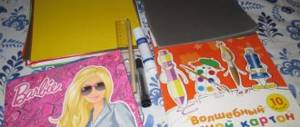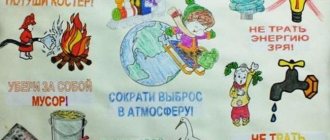Middle group. Junior preschool age. Children 4 - 5 years old
Updating the content and forms of environmental education for middle group children through project activities Updating the content and forms of environmental education for middle group children through project activities . “A man became a man only when he saw the beauty of the evening dawn and clouds floating in the blue sky, heard the nightingale singing and experienced admiration for beauty...
Environmental project “Sorceress-Water” in the middle group
Environmental project “Sorceress-Water”
.
Middle group, teachers: Izokaitis E. G. and Kochedykova N. N. The goal of the project : to expand children’s knowledge about the properties of water, the role of water in human life and other living organisms, to cultivate a caring attitude towards the natural resources of our...
Organization of environmental projects
For environmental projects in different groups, it is preferable to choose topics related to the native land. Observations and experiments that are carried out in real conditions will bring more benefits than those that the child watches a video about or reads about in a book. The development of project activities goes through three age stages.
In younger groups
The beginning of the first stage refers to the age of 3–4 years. Search activity is natural for children. They explore the world, they are interested in everything. Starting from the age of three, they use this type of work as an environmental project. The leading role still belongs to the adult. Teachers usually choose practice-oriented, game projects. Environmental education begins with the immediate environment. Let the kids look at what flowers grow in their flowerbed and watch the insects. At 3–4 years old, any little thing encountered on the street is a discovery.
The theme "Native Trees" is suitable for this age group. As part of the project activity, kids will learn what deciduous and coniferous species grow in the yard. They will observe when the leaves appear, what color they are, and what happens to them in the fall. Different forms are used:
- an adult's story;
- conversation;
- excursion;
- observation;
- walk;
- Reading books;
- viewing photographs, pictures, reproductions;
- watching videos;
- acquaintance with folklore.
In a kindergarten setting, group projects are chosen for 3-4 year olds.
In middle groups
The second stage begins at the age of four. Students become more independent, and the goals of the project become more complex. Life experience does not yet allow one to show independence in choosing a problem; activity proceeds at an imitative-executive level.
Important! Students can act as “customers” of the project, asking questions of interest.
Forms and methods of research activity are moving to a new level. Work on the topic “Flora of my region” includes activities such as collecting a herbarium and compiling a photo album. Co-creation between children and adults is a mandatory component of the project.
Family project
Pupils can engage in socially significant activities. They don’t just observe what flowers grow in the flowerbed, but they themselves plant a flower garden. Working on the theme “Our Flowerbed,” the kids get to know the flowers and choose which ones will grow in their area. Together with adults, they will sow seeds and wait for germination. The result is a beautiful blooming flowerbed that they will be proud to show to their friends and relatives.
Forms, methods and means of environmental education
The study of spectral colors can be carried out in the form of a project activity by choosing the theme “Rainbow”. By the age of 4-5, kids should know the basic colors, this project will take them further. They will get acquainted with shades and learn what colors are obtained when mixing paints. During the work, they will become familiar with the concept of spectrum, learn poems and songs, and conduct scientific experiments.
For older groups
As they get older, social experience accumulates and students begin to cooperate with each other. It's time for paired projects. At the psychological level, noticeable changes occur: the ability to self-control appears, impulsive impulses become less frequent, and self-esteem develops.
The senior group uses different types of projects:
- research;
- creative;
- role-playing
Important! An environmental project in the senior group provides for organizational initiative on the part of students.
It is expected to develop the ability to find ways to solve a problem and develop the desire to use environmental terms in speech. The words “save the environment” are filled with meaning.
Excursion with Little Red Riding Hood
It would be appropriate to carry out the project “We are your children, Earth!” The teacher raises the problem of garbage in public places, explains why the forest is useful, what the “Red Book” is and what animals are listed in it. The planet takes care of earthlings like a mother, she feeds, clothes, gives warmth and beauty, and they must respond in kind.
In preparatory groups
The third stage of development of project activities refers to the preparatory group. It is characterized by a high level of interest, which is due to the development of cognitive abilities and personality traits. Adult activity gives way to support for children's initiative. An adult creates conditions for independent activity of pupils and organizes a cognitive space.
The ecology project in the preparatory group is of great importance for the development of the personality of students, as it involves the formation of ideas about the relationship between the natural environment and humans.
Note! Project activities have socially beneficial significance. Making bird feeders will allow you to feed the birds in winter. The plan may include events such as the release of leaflets, poetry readings, and a drawing competition.
Ecological landing
The projects pay great attention to the scientific basis. You can touch on the following questions: where do microbes come from? What is the harm from sewage? What is ice? What are north and south?
Classes on the topic of ecology in 2 junior groups of preschool educational institutions according to the Federal State Educational Standard
The result of project activities in the preparatory group should be the following:
- understanding the relationships in the natural environment;
- respect for the environment;
- development of basic environmental knowledge and culture of behavior;
- creation of a unified educational space for environmental education.
Types of environmental projects in kindergarten
Projects are divided into several types based on their duration. This takes into account the age of the participants and the problem being studied.
Short
Projects aimed at solving a small problem and not requiring a large investment of time are considered short-term. When developing a project on ecology in the senior group of a kindergarten, short-term in duration, you can turn to the topic “Spring-Wizard”. The goal will be to reveal the characteristics of the season through the integration of all educational areas:
- cognitive development (conversations, excursions);
- social and communicative (games);
- speech (memorizing poetry);
- physical (walking);
- artistic and aesthetic (matinees).
Note! For clarity, it is convenient to use presentations on the problem under study. Home project protection activities are encouraged in many kindergartens.
Long term
Researching a big problem takes a lot of time. It is better to implement them with older students who have the skills to work on the project.
You can invite the kids to work on the topic “Vegetable garden on the window.” The activities necessary to complete research tasks will take more than one month.
Planting onions
During the work, students will gain new knowledge about cultivated, wild, and medicinal plants. They will develop skills in caring for seedlings, they will develop observation skills and a sense of responsibility.
Network projects
The relevance of Internet projects is dictated by the development of digital technologies. The project, launched online, makes it possible for an unlimited number of students, teachers, and parents to connect to solving the problem. Theme: “The globe, for me you are a dear face!” provides many solutions, it will be correct to solve the problem on a large scale.
The practice-oriented significance of events is increasing. This form of work makes it possible to create the basis for a new model of environmental education, which is the environmental movement. There is an opportunity to see your institution against the background of other organizations.
Project on environmental education in the middle group “Love and know your native land”
Project on environmental education in the middle group
“Love and know your native land”
Project type:
cognitive-creative, research.
Project participants:
middle group children, group teachers, parents.
Dates
: two weeks
Relevance of the project.
Our whole life is closely connected with the nature around us. Nature gives us everything we need for life, so we need to protect it.
It is in preschool age that a child perceives his surroundings most emotionally, he is able to sympathize, empathize, and sincerely be surprised; on this basis, it is possible and necessary to develop in children a love for nature and its inhabitants. Modern children are growing up in a consumer society; most people do not even realize how much harm each individual does to the environment.
One of the pressing problems of our time is the problem of human interaction with nature. It is common knowledge that the state of the ecosystem has deteriorated significantly recently. This is facilitated by forest fires, deforestation, livestock grazing, air pollution, resource depletion, littering of forests, destruction of medicinal plants, destruction of bird nests, etc. In order for an ecosystem to be healthy and strong, it must be protected and protected. The problem is the lack of ecological culture and environmental consciousness among people, the lack of a system of direct communication with nature.
Objective of the project:
introduce children to the nature of their native land, promote the manifestation of a conscious and moral attitude towards nature in children of middle preschool age and their parents through direct communication with the ecosystem, develop in children the ability to observe, compare, draw conclusions, develop creative imagination, and form an ecological culture.
Project objectives:
-Give children an idea of the types of plants growing nearby, the types of insects and animals of their native land.
-Cultivate a caring attitude towards nature through actions
-Introduce environmental protection signs
Predicted result:
— increasing the level of knowledge among parents and children about the ecology of their hometown, region, and nature conservation
— creation of wall newspapers, leaflets and photo albums during the project
- attracting parents to participate as much as possible in the environmental education of children
- awareness by children and adults of the importance of nature conservation, environmentally appropriate behavior in the environment, and not littering it.
Project stages.
Preparatory:
– what will happen if one species of insects (plants or animals?) disappears from nature
- Why might this happen?
- How will this affect us?
- How to prevent this?
— Reading children's literature, environmental fairy tales and watching the presentation “What will happen if insects disappear”
Forms of children's activities
Examination of illustrations on the topic “Ecological chain”;
Learning poems about the inhabitants of the steppe, about nature;
Guessing riddles about animals and plants;
Designing a paper tulip
Coloring pictures on the theme “Take care of tulips”, “Nature conservation”
Drawing “Steppe in spring”
Didactic ecological games “Collect an insect”, “The fourth odd one”, “One is many”, “Name it affectionately”, etc.
Watching a cartoon, presentation
Stage 2 - organizational - practical
Contents of work on environmental education
The task of the stage: creating an ecological environment in the group, involving parents in the upcoming creative work in an innovative mode;
1. Conduct a block of environmentally oriented children’s activities to study the bushes growing on the site.
2. To develop skills in environmentally literate behavior of the younger generation.
4.Develop a consultation for parents;
Methods and techniques for working with children on environmental education
- conversations and conversations with children on environmental topics;
— didactic games;
- reading literature;
— review of demonstration material;
- memorization of poems, proverbs, sayings;
— design of the wall newspaper “Take care of the nature of your native land!”
Improving the subject-development environment in the group (ecological corner).
Replenishment of the ecological corner with didactic and visual material.
Conversations:
— “Birds of the Native Land”
- "Forest Orderlies"
— “Rules of behavior in nature.”
Writing riddles, stories and fairy tales about the steppe;
Watching the cartoon “The Boy and the Earth” https://www.youtube.com/watch?v=EEdn6igiEXo
Research activities while walking.
1. Take a magnifying glass and examine the ant.
Generalization: Ants live in an anthill as one large and friendly family. There are as many ants in one anthill as there are people in a big city. The queen ant rules the anthill. When she was young, she had small wings and loved to frolic and fly. But then, having become the venerable mother of a large ant family, the ant gnaws off her wings and from then on lives in an anthill. She lays eggs, from which larvae will later emerge. Worker ants will take care of the larvae: feed and care for them. Ants, once born, do not grow. The way they were born is the way they are useful. The ant has a thickened abdomen, chest, head, and three pairs of small legs. The ant has strong jaws. Like all insects, ants have antennae, with the help of which the ant receives information about smell, taste and communicates it to its fellows.
Ants can walk on smooth or inclined surfaces. After all, on each paw the ant has two claws, between them there is a pad that secretes a sticky liquid, which allows the ant not to fall.
Ants love to feast on the spandex most of all - this is the name of the substance secreted by aphids. Ants also eat other insects, especially grasshoppers. There is even a saying about this: “The best gift for an ant is a grasshopper’s leg.” They also eat mushrooms, juice and plant seeds.
Ants are predators; they destroy many harmful insects, which is why they are called “forest orderlies.” Some birds specifically fly to ants for help, who cleanse the bird of numerous parasites and lubricate its feathers with formic acid. Ants also have enemies. Many birds, amphibians and reptiles feed on ants, as well as
badgers, foxes, bears and other animals. The nests of red forest ants are used as winter roosting sites by wild boars.
2. Cover the path with granulated sugar and watch how the ants collect it.
Result: At first, the ants will just fuss and run randomly in different directions. Then they will calm down and you will see one or more long chains of ants moving to and from the treat.
Explanation: Ants perceive a complex system of information using special chemicals - pheromones - secreted by their bodies. As soon as one ant finds food, in our case sugar, it begins to leave behind a pheromone trail, along which other ants follow. The more ants follow the trail, the stronger the signal becomes. It is interesting to observe how ants exactly repeat the trail of the very first ant, even if it takes a long path, for example, crawling around a pebble. Finding food is just one of the many functions of pheromones. Pheromones convey complex chemical information. If you scare an ant, it will immediately give other ants a signal warning of danger. In this case, ants located close to this signal will run away, and soldier ants located further away, on the contrary, will prepare to attack.
Observations.
Getting to know the sounds of nature, listening to an audio recording with the sounds of nature, excursions along an ecological trail. Goal: to teach children to identify sounds in nature, to consolidate the ability to observe, compare, analyze, and draw conclusions about natural objects.
Visual activity.
Software tasks:
continue to form children’s understanding of living nature; improve knowledge about nature conservation; introduce proverbs, nursery rhymes, proverbs, proverbs about nature; cultivate a love of nature; cultivate the habit of maintaining correct posture in all activities.
Fiction
Reading the work of O.M. Maslennikova “Why the hedgehog doesn’t meet spring”, (“Ecological projects in kindergarten” O.M. Maslennikova, A.A. Fillippenko, p. 219) Tatyana Yakovleva “The Tale of the Trash - the Damned” https://www.sreda- info.ru/projects/skazki.html
Play activity
Design from paper “Tulip”
Didactic games:
1. “Compare.” Goal: each child talks about his tree and compares it with another.
2. “What is unnecessary.” Goal: children must identify the extra object (oak, aspen, maple, spruce, chamomile).
3. “Name the fruit.” Goal: Children must correctly identify the fruit of this plant.
4. “Identify a tree by its leaf.” Goal: children must name the tree based on the leaflet.
Games: “Good - bad”, “Living - non-living”, “Who lives where”, “Find out what kind of animal”, “Which tree is the leaf from”, “When does this happen? ", "House an animal", "What would happen...", "Whose, whose, whose? ", "I know 5 names...", "Ecological chains";
Stage 3 is the final stage.
Development and creation of a wall newspaper “Take care of the nature of your native land.”
Final event: environmental holiday “Steppe Day”
Photo exhibition
Working with parents:
-Consultation “Teach children to love nature”!
—
Participation in an environmental holiday
Scenario of the environmental holiday “TAKE CARE OF THE STEPPE”
»
Teachers: Khartskhaeva T.I.
Ubushaeva S.V.,
Musical director Zubkov O.E.
Target:
Continue to introduce children to the inhabitants and plants
of the steppe
. Develop creativity, curiosity, memory, attention, research skills.
Raise a caring
attitude towards the nature of the native land.
Material and equipment:
wall newspaper “Take care of the steppe!”, exhibition of drawings by children and parents “Take care of nature”, pictures of animals and plants of Kalmykia, USB drive with recordings of songs for the holiday
The progress of the holiday
Educator: Dear guys! Every day we discover something new around us. You may not notice it, or you may think about everything you see around you. And then you will all love the beauty of your native steppe with a special love
. Let's clarify what the steppe is?
. The steppe is like the sea ! In early spring this sea is multi-colored - green, yellow, red, blue; and when the white feather grass thickens, the steppe will turn silver . And waves of the steppe wind and dark shadows of light clouds will flow across the silvery plain.



